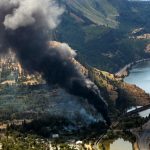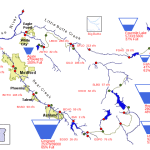Postcards from the Rogue Valley
“Begin at the beginning,” the King said, very gravely, “and go on till you come to the end: then stop.” ― Lewis Carroll, Alice in Wonderland
This Land Was Their Land from Barbara Cervone
Here in the Pacific Northwest, acknowledgments that recognize Indigenous Peoples as traditional stewards of the land have become de riguer. They are spoken at the beginning of public and private gatherings, from live performances to sporting events to town halls.
Before actors take the stage at the Oregon Shakespeare Festival in Ashland, for example, a spokesperson announces: “We would like to acknowledge that today we gather on the land of the Takelma and Shasta peoples, recognize the many tribes and bands who call the Klamath Basin region their ancestral territory, and highlight the continued sovereignty of nine tribes of Oregon and the Northern California tribes who have ties to this place.”
Such acknowledgements, of course, do not address, in real terms, the extermination of Native peoples locally or across America. Indeed, Indigenous anthropologists reportedly worry that land acknowledgements may sanitize the trauma of dispossession rather than being taken for what they are: a starting point for justice.
Truth is, the Native genocide goes beyond words. Prior to Columbus’s arrival in 1492, America boasted thriving indigenous populations totaling more than 60 million people. A little over a century later, that number had dropped to 6 million.
History tells us that European contact brought with it not only war and famine, but also smallpox and other diseases that decimated local populations. Indeed, a recent “quarternary science” study shows that those deaths occurred on such a large scale that they led to a “Little Ice Age”: an era of global cooling between the 16th and mid-19th century. As the indigenous population disappeared, large swaths of vegetation and farmland were abandoned. The trees and flora that repopulated this unmanaged farmland started absorbing more carbon dioxide, removing enough greenhouse gas from the atmosphere that the planet’s average temperature dropped by 0.15 degrees Celsius (Science Alert, Feb. 11, 2019).
Where disease left off, the 1851 Indian Appropriations Act took over, expelling Native peoples to reservations barely fit for habitation, out of sight and out of mind. By 1900, the Native American population in this country hit rock bottom—237,000 people—though it has rebounded since to approximately 6 million (with a good portion being Alaska and Hawaiian Natives). That Indigenous people survived at all seems extraordinary.
Earlier this month, Columbus Day welcomed a new partner, Indigenous People’s Day. It is an ironic pairing.
There is much more, read on here https://www.postcards-from-the-rogue-valley.blog/this-land-was-their-land/





